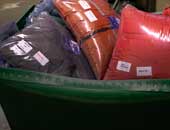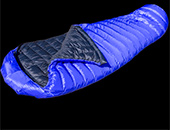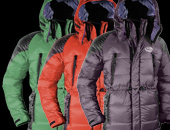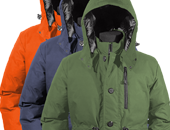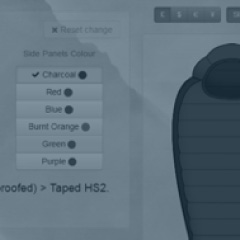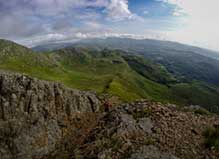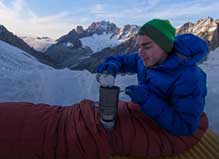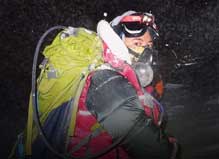"The fit is very good, no crushing of the inner bag ... and the loft is very good ... The fabrics are all excellent, the Drishell used on the Overbag outer is very good indeed. Water resistant enough to cope with spills, drips and a user daft enough to keep dragging snow into the tent ... the Overbag + Minim has been a revelation. Warm enough for me to abandon all clothing bar my coating of 190 weight merino, and although slim cut, I don't feel restricted in it. The two bags interact very well, there is no sensation of multiple layers ... The two bags feel like one, but it's somehow cosier. I dare say it's one of those things that you have to try, but I have to say I have been warm, comfortable even delighted using these bags ... I think it's good to look at the two bags as a system and as individual bits of kit. That way it does kinda cover the whole year, does that mean it's all you need?"
— Peter McFarlane, a.k.a Petesy, using PHD Overbag with a PHD Ultra.
"Just back from an 18 day trek in the region around Everest. I knew the conditions were going to be pretty cold, camping for quite a few nights at around 5000m - night temperatures fell well below minus 15c. Just before I left I purchased the synthetic Overbag bag to go with my Minim 400. The combination worked a treat and - with my Ultra down vest - I never once felt cold during the long nights - even without the hood done up fully. Everything else froze - condensation from my breath turned to ice on the inside of the tent! I was the only one to have such luxury and my trekking companions were just a little envious of my warm glow!"
— Gordon G.
""I 'bivvied' in the snow on the fell above my house. Inside a bivvy bag I was as 'snug as a bug' in the Overbag and Filler. So much so that I slept until 8am. The temperature dropped to about -6°C."
— S.C.
"No one I know goes hiking in a big thick woolly jumper, so applying the layering principle to sleeping bags makes as much sense as it does for clothing. This past summer I used the PHD Minimus and PHD Down Overbag.
Immediately the benefits became obvious. Two smaller bags took up about the same space as my old bag, but were considerably easier to pack into dry bags each morning. Stowing them in separate compartments reduced the chance of them both getting wet and made packing the kayak much easier with less wasted space.
On occasions when conditions were [warmer] the inner bag was more than sufficient on its own – at these times I didn't even unpack the second bag from the kayak, thus saving time and energy the following day. Being able to slide either the inner bag down round your legs or the outer bag off made regulating your temperature easy on warmer nights.
It's now so obvious - I can’t believe it's taken me 30 years to apply this layering principle to my sleeping system."
— Martin Rickard, www.seakayakadventures.co.uk
"I have a long-held belief in the 'layering principle' extending into sleeping bags. PHD's bags suit a multitude of adventure activity situations including:
- Expedition sea kayaking
- Himalayan style trekking where you travel through a wide range of temperature zones
- Cycle touring where there is a similar packing issue to sea kayaking and potential for travelling through temperature zones
- Plus, anyone who needs to use their sleeping bag across seasons. E.g. Just 'layer up' to convert your summer bag into a 'winter warmer'
During recent sea kayak expeditions in Greenland, my PHD
Overbag,
Filler bags were tested in temperatures ranging from just above freezing to as low as -10°C. It is a pleasure, when you know the temperature is dropping, just to slip into another bag and double the warmth factor"
—
Sam Cook

